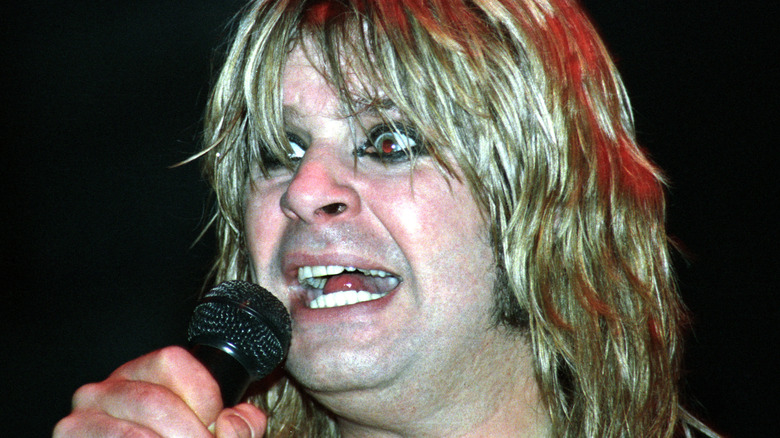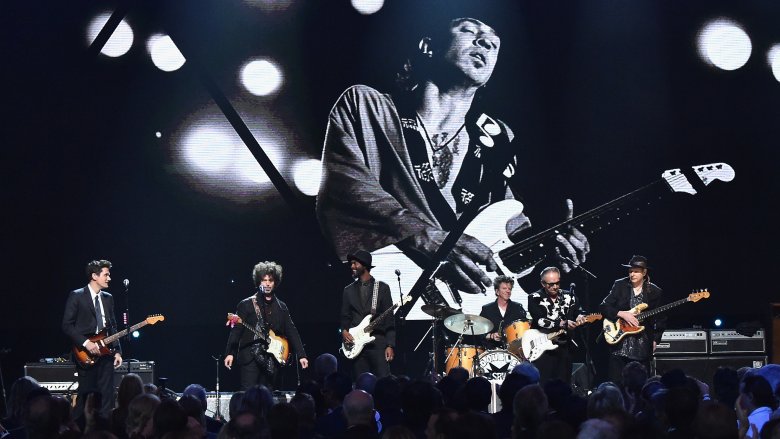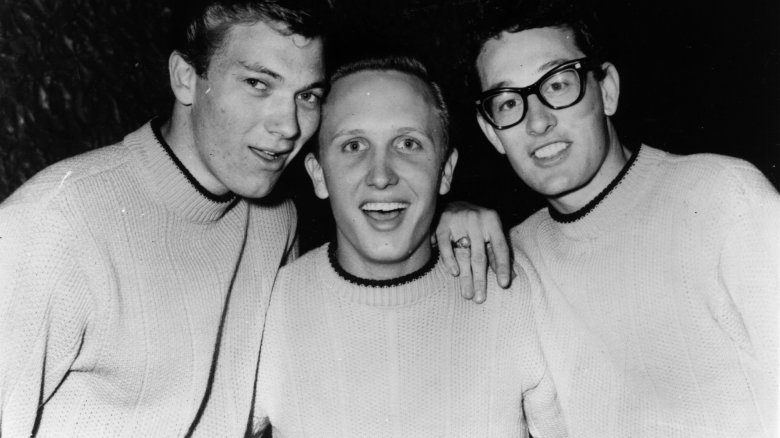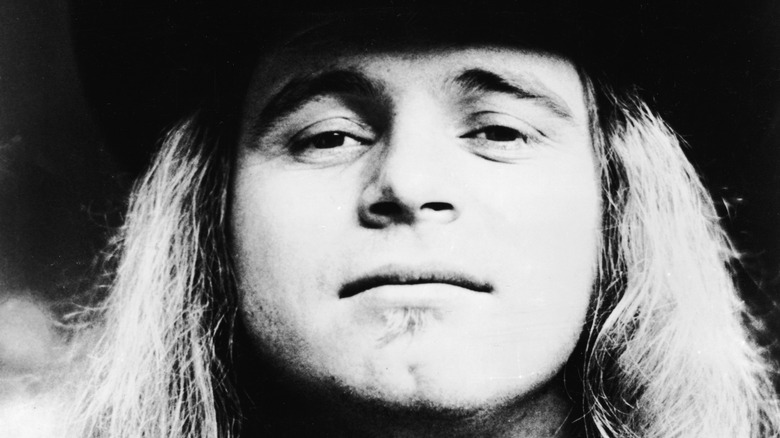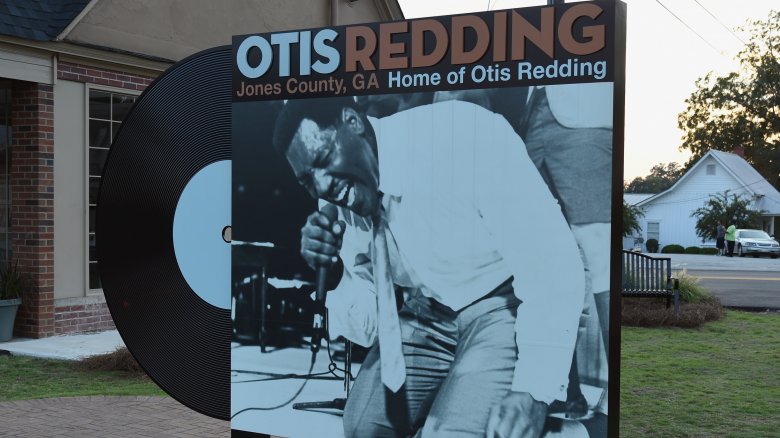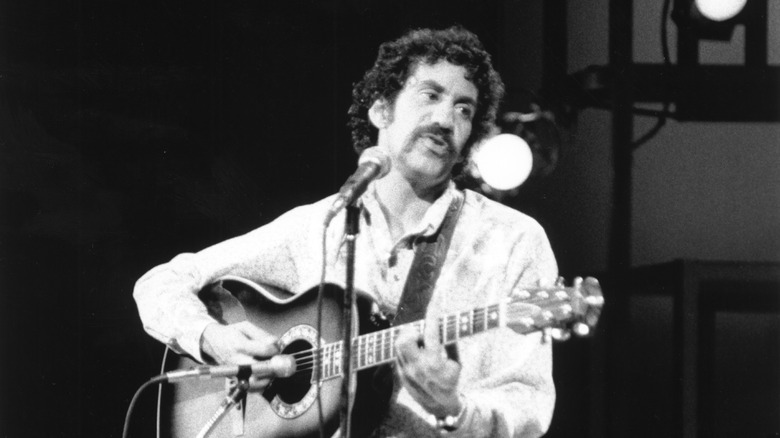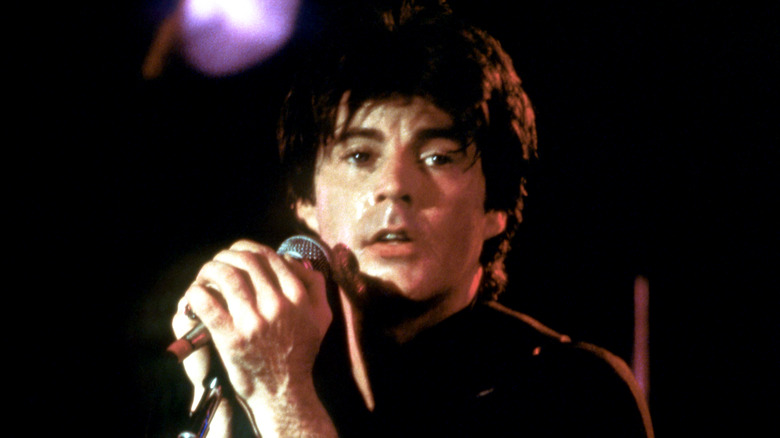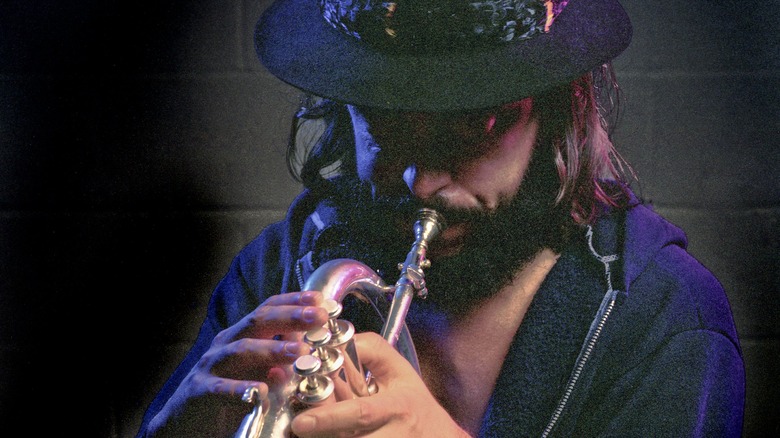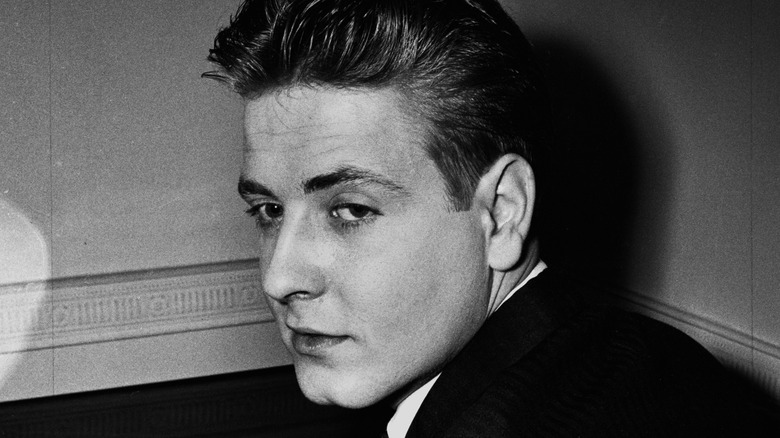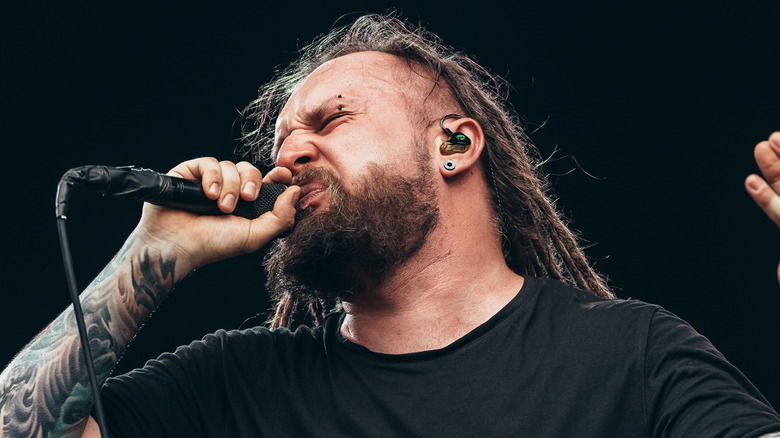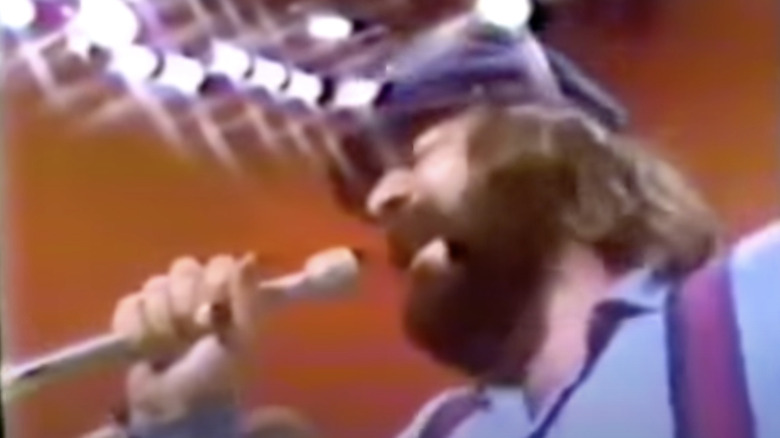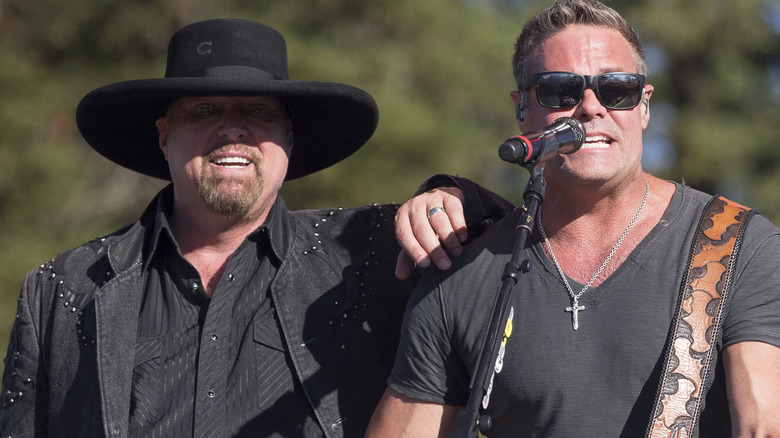Bands That Were In Tragic Accidents While Touring
There's nothing quite like the excitement that comes with an announcement that a favorite band is going on tour. There's the initial thrill, checking out the venues, then crossing your fingers in hopes more tour dates are going to be announced. The mad scramble for tickets, the hope of getting decent seats, and entering all the inevitable contests in hopes of scoring better seats ... it's a whole thing.
But sometimes, tours can go horribly wrong. Just consider how many shows any group is going to be playing, where they're located, and how much distance there is between gigs. Now, look at how much time they actually have to get from Point A to Point B ... then on to Points C, D, E ... and onward, usually for months at a time. They criss-cross the country and sometimes the world, and it's seriously impressive that they even know what city they're in. Most of the time, at least.
All that travel — and all that exhausted travel — makes it not entirely surprising that sometimes, there are horrible, life-altering accidents while on tour.
Metallica
According to Ultimate Classic Rock, Metallica was in Sweden promoting their latest release — "Master of Puppets" — and heading to their next tour date when, just before 7 a.m. on September 27, 1986, the driver skidded on a patch of black ice and lost control. The tour bus flipped and threw bassist Cliff Burton through a window. What happened next is told differently by people on the scene, but they all agree that when the bus landed, it landed on top of Burton and killed the 24-year-old musician. There were, of course, questions as to whether the accident could have been prevented, but an investigation cleared the driver of any wrongdoing.
James Hetfield painted a heartbreaking picture of the accident, telling In the Studio: "Coming out and finding your buddy under the bus is not something you want to go through. Our first reaction was anger. ... Why did this happen? ... There were screams from the crew who were still trapped in there, screaming in pain."
In a bizarre footnote, Burton was sleeping on a top bunk when the accident happened, and he'd ended up there because of a single draw from a deck of cards. He and guitarist Kirk Hammett drew cards to choose who was going to get the pick of the bunks, and Burton won with the ace of spades. He chose the bunk that Hammett had been using, and ultimately died.
Stevie Ray Vaughan
Stevie Ray Vaughan's 136-show In Step Tour kicked off on May 4, 1989, and ended with an epic show featuring Eric Clapton (via SRV Archive) followed by a tragic helicopter accident that took one of music's most respected guitarists.
The show was at Wisconsin's Alpine Valley Musical Theater, and after the show, a group of four helicopters had been reserved to fly the performers back to their Chicago hotel. According to Guitar World, one of the choppers had been reserved for Vaughan, his brother, and his brother's wife. Some of Clapton's entourage was already on board, though, and Vaughan asked to swap in.
It was only the next morning that reports started to go out that the chopper had never reached its destination, and when friends found Vaughan's hotel room empty, they thought the worst. By 7 a.m., Vaughan's brother was called and asked to identify his body. Vaughan — along with everyone else on the chopper — had died only half a mile into the flight, when the pilot banked sharply in the fog and collided with a ski slope. Eerily, only the day before Vaughan had shared a disturbing dream with his bandmates: He had dreamed he was a witness to his own funeral.
Dropkick Murphys
The end of 2014 was a bad time for Celtic punk rockers the Dropkick Murphys. On November 13, Al Barr received word that a childhood friend had passed away. He posted that he was going to be unable to make their next scheduled show in Tulsa, Oklahoma, as he would be flying out to attend his friend's funeral.
But to add to the tragedy, Loudwire says they never made it to the airport. The next announcement was that they were canceling their Tulsa show after their tour bus hit and killed a pedestrian who had run into the street in front of them.
The Boston Globe later identified the man as a 23-year-old father of one, adding that the accident had happened just north of Austin on Interstate 35. Even as the Dropkick Murphys posted about their show cancellation, condolences, and a request their fans keep the family of the man in their prayers, the family returned the sentiment with sympathies to all the band members involved and to the bus driver.
Ozzy Osbourne
Black Sabbath had given Ozzy Osbourne the boot in 1979, but by the early '80s, things were sort of back on track. Rolling Stone credits guitarist Randy Rhoads for that, and Ozzy says Rhoads' accidental death still haunts him. "To this day, as I'm talking to you now, I'm back in that field looking at this f*cking plane wreck and a house on fire," Osbourne said in 2018. "You never get over something like that. You're in shock."
And it was a bizarre accident. According to Ultimate Classic Rock, bus driver Andrew Aycock (who had an expired pilot's license) hopped in a small 1955 Beechcraft Bonanza with Rhoads and a woman named Rachel Youngblood. With Ozzy and the rest of his band asleep on the tour bus, Aycock buzzed the bus a few times before losing control, hitting a tree, and crashing into a house. The three were killed instantly, and the incident had a lasting impact on the other band members — particularly Rudy Sarzo, who parted ways with Ozzy and returned to Quiet Riot after the accident. Sarzo simply said, "It was so painful to go onstage without Randy, so I just left one of the biggest bands in the world for nothing, no promises, no nothing, just so I could enjoy playing again."
It was Sharon Osbourne who pushed them to move on. Within a week and a half, they were back on tour with replacement guitarist Bernie Torme.
Gary Numan
Yes, Gary Numan is absolutely still around, and in early 2018 he announced (via Consequence of Sound) that he was going to be going on tour — for a second time — to support his 22nd album, "Savage (Songs from a Broken World)." That was in April, and it was in September 2018 that he canceled a show at the House of Blues after his tour bus was involved in a tragic accident.
According to Rolling Stone, Numan's tour bus was making a right turn when it collided with a 91-year-old man who had been pushing a cart through a crosswalk. The man died at the scene and was given last rites by a priest from a nearby church.
Numan not only canceled the show but issued this statement: "We are all utterly devastated by the fatal accident involving our tour bus earlier today. Every one of us is filled with a sadness that made it impossible to even consider playing our show this evening, and out of respect it would have been entirely wrong. ... At the moment all we can think about are the people affected by this terrible tragedy, and to them we send our love."
Buddy Holly
February 3, 1959, was forever immortalized as The Day the Music Died, although everyone from The Beatles and the Rolling Stones to Bob Dylan and Elton John would be inspired by Buddy Holly ... who stayed 22 years old forever.
Three of the biggest up-and-coming rock stars of their day were on the plane that crashed not long after takeoff. It claimed the lives of Buddy Holly, Ritchie Valens, and J.P. Richardson Jr., better known as The Big Bopper. They had just finished playing a show in Iowa, part of their very 1950s-sounding Winter Dance Party Tour. The concerts were amazing, but the travel part was less than ideal.
According to the Independent, they were faced with a 400-mile journey to their next gig, and no one wanted to make the trip on their freezing, malfunctioning tour bus. Holly decided to charter a private plane, but there were only so many seats. Holly took one, Valens won another on a coin toss, and another musician — Waylon Jennings — gave his seat to Richardson, who was suffering from the flu. For the rest of his life, Jennings would be haunted by the good-natured but, in hindsight, horrible exchange he had with Holly just before the plane took off: "I hope your damned bus freezes up again," Holly had told him. Jennings' response? "I hope your ol' plane crashes."
There were no survivors.
Lynyrd Skynyrd
Lynyrd Skynyrd's iconic album "Street Survivors" had hit shelves only a few days before they boarded their leased, 30-year-old plane in spite of many misgivings. They'd already played five shows on the tour, and it had gone well — they were sitting on top of the world, but no amount of success can persuade the Reaper to look the other way.
According to Rolling Stone, they had plans to upgrade their old Convair 240 to a Learjet, and their 600-mile flight from Greenville to Baton Rouge was going to be one of their last trips in the Convair. It was — but not for the reasons they thought.
Survivors said nearly everyone onboard (except Ronnie Van Zant, pictured) had misgivings about the trip — misgivings amplified by the fact that just a few days earlier, flames had been seen spitting from one of the engines. But Van Zant was adamant, pushing them with these fateful words: "Hey, if the Lord wants you to die on this plane, when it's your time, it's your time. Let's go, man. We've got a gig to do." The plane crashed around three hours later. Ronnie Van Zant, Steve Gaines, and his sister, Cassie, lost their lives in the Mississippi swamps.
Strangely, Van Zant had been convinced that he would die before he turned 30, and he was just a few months shy of his 30th birthday when the plane went down.
Reba McEntire
There's no denying that a single decision can change the course of an entire life, and for Reba McEntire, that decision happened in 1991. McEntire and her band had finished a show in San Diego and were heading to their next gig. She, her husband, and her stylist decided to spend one more night in California, while the others went on ahead in two separate planes. The second plane made it to its destination, but 10 miles from the destination, tragedy struck the first plane as it carried eight of McEntire's close friends and bandmates (via The Boot).
According to Taste of Country, one of the plane's wings clipped a rock protruding from the side of Otay Mountain. No one survived the crash.
Other country music superstars stepped up, even offering to give McEntire their own backing bands so she could continue on and finish her tour, but she declined. She continued to memorialize the crash and remember those she lost, dedicating her next album — "For My Broken Heart" — to those who died in the crash. She visited the crash site on the 25th anniversary of the tragedy, posting on social media: "I feel in my heart that they know we still miss them so much. My love and prayers to all the families and friends."
Gloria Estefan
Some people are fortunate — and determined — enough to turn a tragedy into something good, and that's exactly what Gloria Estefan has managed to do. In 1990, she was headed for Syracuse when her tour bus was rear-ended (via Syracuse). Her injuries were catastrophic: She broke her back and was told there was a very good chance she would never walk again, much less get on stage and dance. Years later, Estefan talked frankly about the accident on "Oprah's Next Chapter." "Those things can ... tear you apart. It's hard to handle."
But she gives her husband a huge amount of credit for aiding in her recovery, which included nine months of therapy, every day, for seven hours a day. She was up and out of bed every 45 minutes, not because her therapy called for it but because she was in too much pain to sleep.
She came to this conclusion: "At first, I just wanted to walk again. And then I thought, 'Maybe this was the whole point of me becoming famous, to now go through something like this in the public eye and hopefully show people how much power we actually have and what we can do to help change our destiny." Estefan has gone on to do charity work, campaigning, and fundraising, all in hopes of furthering medical research done on spinal cord injuries and paralysis (via FOX News).
Trace Adkins
According to CNN, Trace Adkins was already at the CenturyTel Center in Bossier City, Louisiana, in 2010 for his scheduled show when he got the news that his tour bus had been involved in a horrific accident just north of Shreveport.
Five members of his band were on the bus, though, and while they suffered only minor injuries, the two men who were in the Ford F-250 when it collided head-on with the tour bus were killed.
According to the official investigation (via The Boot), the truck had been swerving as it approached the bus, and the bus driver was unable to avoid it. Ultimately, the cause of the accident was ruled to be driver fatigue — the men in the truck had been up for around 24 hours at the point of the accident and were on their way home from an all-nighter at a nearby casino. Adkins played a "scaled-down" version of his show following the accident and canceled his show in Pensacola.
Otis Redding and the Bar-Kays
Otis Redding, the 26-year-old well-driller turned megastar, died not long after unseating Elvis Presley as the Melody Maker's top male vocalist (via Rolling Stone). He was seeing the fruits of his labors, too — the tour that he died on was the first tour where he was using his own, newly purchased private plane. Redding and his backing group, the Bar-Kays, were only 4 miles from their destination — the Madison Municipal Airport in Madison, Wisconsin — when the plane crashed into a nearby lake. It had been covered with fog, and days later, rescue divers were still dredging the lake to try to recover those who had been on the plane.
There was one survivor: Ben Cauley. A seat cushion saved his life, and he — along with fellow Bar-Kay member James Alexander, who was on another plane — rebuilt the group and later toured with Isaac Hayes, Aretha Franklin, and the Doobie Brothers. Any accident like this is terrible, but the deaths of the Bar-Kays were particularly heartbreaking: They were still in high school at the time, and some were so young that Billboard says they needed permission slips from their parents to miss school and go on the tour.
There's a footnote here, too. CL Tampa Bay says the accident came just three days after Redding recorded what would be one of his most iconic songs: "(Sittin' On) The Dock of the Bay."
The Ghost Inside
In 2015, The Ghost Inside was on their way from a gig in Texas to their next show in Phoenix when they were involved in a catastrophic accident.
They were just outside El Paso when a truck hit their tour bus head-on. At first, details were sketchy. NME reported that the driver of their tour bus and one person in the other vehicle had been killed, and drummer Andrew Tkaczyk had been seriously injured. In the immediate aftermath, his brother Nick said Andrew had suffered head trauma, a shoulder injury, and broken bones. It later came out that Andrew had spent 10 days in a coma and had one of his legs amputated.
It wasn't until 2018 that Digital Music News reported there might be the possibility that the group would play again. Tkaczyk had been fitted with a prosthetic (not ideal for playing), and his father built a device that adapted his drums to his missing leg. The Ghost Inside currently has plans to play a single live show in July 2019, but what will happen after that is unclear.
Jim Croce
Folky singer-songwriter Jim Croce had given up on music and gotten a job in construction after his first album, recorded with his wife, Ingrid, had flopped, according to Rolling Stone. Then ABC/Dunhill Records gave him a second chance, and signed Croce to record a couple of singles. Both songs, "You Don't Mess Around with Jim" and "Operator" reached the Top 20 of the pop chart in 1972, prompting the recording of a full album and the No. 1 hit "Bad, Bad Leroy Brown" in April 1973. Just six months later, Croce was dead.
According to the Associated Press (via the Spokesman-Review), Croce booked a string of concerts at colleges in 1973, and after playing a show at Northwestern Louisiana University, he and his band boarded a small, chartered plane to make it to their next show in Sherman, Texas. Unable to reach a safe altitude, the plane crashed right after takeoff, striking a tree 250 feet past the runway. Six people in the vehicle died, including comedian and Croce opening act George Stevens, accompanist Maurice Muehlelsen, manager Dennis Fast, booking agent Dominick Cortese, pilot Robert Newton Elliott, and Croce, who was 30 years old.
Rick Nelson
Rick Nelson was one of the very first rock n' roll stars. He was also the prototypical musical teen idol, crooning instant hits each week on "The Adventures of Ozzie and Harriet," the long-running sitcom in which he starred with his family, according to AllMusic. After a string of hits in the late 1950s like "I'm Walking," "Poor Little Fool," and "Lonesome Town," Nelson had a major comeback hit with the bitter country rock lament "Garden Party."
Following a show in Guntersville, Alabama, in December 1985, according to The New York Times, Nelson and his band took the musician's DC-3 airplane to Dallas, where they were to play a New Year's Eve gig at the Park Suite Hotel. Eyewitnesses saw the plane circling above the northeastern Texas town of De Kalb. Responding to the ominous activities, the Texas Department of Public Safety dispatched a helicopter to assist, and Nelson's pilot reported an onboard fire and that he needed to make an emergency landing. Moments later, the plane, engulfed in flames, careened into a forest and hit a power line on the way down, causing the aircraft to explode when it hit the trees. The pilot and co-pilot survived, albeit badly burned. The seven passengers all died, including 45-year-old Nelson, his fiancée, and his band.
Chuck Mangione
Ultra-smooth, utterly sophisticated soft rock had a big cultural moment in the late 1970s, and few embody that era more than Chuck Mangione. He's one of the few players of the flugelhorn (a brass instrument related to the trumpet) to ever achieve major pop success, according to The Washington Post. And he did so with "Feels So Good," a lyrics-free, easy-listening jam with a hooky melody played by Mangione himself and accompanied by some funky, disco-adjacent rhythm and bass. It went to No. 4 on the pop chart and was the first of many times Mangione would score on the adult contemporary chart.
On the evening of February 12, 2009, according to the CBC, a flight departed from Newark, New Jersey, in the direction of Buffalo Niagara International Airport in New York. Among the 49 passengers were Gerry Niewood and Coleman Mellett, saxophone and woodwind player and guitarist, respectively, in Chuck Mangione's backing and touring band. They were scheduled to play with Mangione and the Buffalo Philharmonic, a show that was canceled after the musicians' plane crashed into a residence outside Buffalo. According to NPR, all 49 passengers died, including 64-year-old Niewood, who'd played with Mangione in the '60s and '70s, and 33-year-old Mellett.
Eddie Cochran
In the late 1950s, Eddie Cochran's bouncy guitar and raspy vocals helped write the blueprint for the first wave of rock n' roll, pulling equally from country music and R&B. While still in his teens, Cochran repeatedly hit the upper reaches of the pop chart with his songs about partying and youthful frustration, particularly "Summertime Blues" and "C'mon Everybody."
According to History, Cochran's rougher-edged rock n' roll remained popular in the U.K. in the 1960s after softer pop had supplanted such music on the charts in the U.S. That prompted Cochran and fellow early rock n' roll star Gene Vincent to go on tour in the U.K. The shows proved so popular that Cochran and Vincent added an additional 10 weeks of shows. On April 16, 1960, the duo played a concert in Bristol and hired a cab to drive them to the London airport. The driver lost control on a windy section of highway late at night near Chippenham and hit a lamp post. Vincent suffered a collarbone injury, while Cochran was thrown out of the car upon impact. Hours later, he died from the effects of a head injury. Cochran was 21.
La Bouche
In the mid-1990s, dance-pop duo La Bouche scored a string of hits in Europe and the U.S., notably "Be My Lover" in 1995 and "Sweet Dreams" in 1996. According to MTV, producer Frank Farian (who previously assembled Milli Vanilli) put the group together, pairing soulful Atlanta-born singer Melanie Thornton with rapper Lane McCray. Following three La Bouche albums, Thornton gave a solo career a try, and had a hit in Germany with "Ready to Fly." In November 2001, two days before the release of follow-up single "Wonderful Dream," Thornton died in an aviation accident.
The singer was a passenger on a small plane that departed Berlin, Germany, bound for Zurich, Switzerland, where Thornton was scheduled to perform. Just before the plane could safely land, it crashed in a forest near the airport, according to the Associated Press. Thornton was among the 24 people on board who died; the singer was 33.
Her's
According to the BBC, Her's was a band on the rise in the late 2010s. Featured on "BBC Introducing," they released their first record "Invitation To Her's" in 2018, which was well-received by indie rock fans in the U.S. and the U.K. Her's comprised just two musicians: Stephen Fitzpatrick and Audun Laading, who met when they both attended the Liverpool Institute of the Performing Arts. Rock critics enjoyed the band, with The Guardian likening them to the Smiths and Aztec Camera.
In 2019, according to CNN, Her's embarked on a 19-date tour across the United States. On March 26, the duo played a show in Phoenix and took a van to reach their next gig, more than 300 miles away, in Santa Ana, California. In the early morning hours of March 27, the group's vehicle was involved in a head-on collision when it was struck by a pickup. The driver of the truck died, as did all three people in the van — both 24-year-old Fitzpatrick and 25-year-old Laading of Her's and their tour manager, Trevor Engelbrektson.
Khaotika and Wormreich
Khaotika and Wormreich are two different bands that specialize in loud, hard, and heavy subgenres of metal, but they attracted enough of the same audience that they could tour together through the southeastern United States, where both groups formed, according to The Atlanta Journal-Constitution. Khaotika once described its music on its Facebook page (via AJC) as "melodic occult metal," and the band released its first collection, "Bloodline Empire" in 2014. Wormreich, a black metal act, per The Metal Archives, had been knocking around since 2009 with a debut album called "Edictvm DCLXVI."
Khatotika and Womreich toured together in 2015, according to The Atlanta Journal-Constitution. Following a concert in Spartanburg, South Carolina, and on their way to play a show in Atlanta, the van driver fell asleep at the wheel. The car drifted and crashed into a tree. Eight people in the single-vehicle crash were hospitalized, with three admitted to critical care units. Three others died just after the accident as a result of injuries suffered. Nicholas Crisostomo, 25, of Khatokia died, as did 30-year-old Ian McKinney and 29-year-old Paul Truesdell of Wormreich.
Decapitated
According to their official biography, Decapitated formed in Poland in 1996 and by the early 2000s, they'd established themselves as one of the most prominent bands in Polish tech death, a subgenre of heavy metal notable for its difficult and exacting style of shredding. After releasing some well-received and extremely heavy and technically-complex albums, several musicians came in and out of the band, per AllMusic, including original lead singer Wojciech "Sauron" Wasowicz, replaced by veteran metal singer Adrian "Coven" Kowanek.
During a tour of Russia in November 2007, Decapitated's tour bus crashed into a lumber truck near the Belarus-Russian border, according to Onet.pl (via Blabbermouth). Decapitated singer Kowanek and drummer Witold "Vitek" Kieltyka both endured serious head injuries. After falling into a coma, Kowanek experience a cardiac arrest and then a severely interrupted oxygen flow to his brain, which lead to full paralyzation, according to Metal Insider. Kieltyka underwent emergency surgery and was set to be sent home to Poland for more hospitalization and treatment. He never left Russia, dying of his injuries at age 23.
Bayside
Combining hard rock, punk, and emo, Bayside helped create and capture that definitive sound of the early 2000s. The band formed in the Bayside neighborhood of Queens, New York in 2000, according to AllMusic, then quickly released a couple of EPs before signing with Victory Records and putting out their first two full-length albums, the latter of which became the band's first music to hit the Billboard album chart and bring them into the big time.
Weeks later, Bayside's tour took them through the American west, according to Billboard. While heading to a show in Salt Lake City as a support act for Hawthorne Heights, their van encountered an icy section of highway near Cheyenne, Wyoming. The vehicle flipped and landed on its roof. Bassist Nick Ghanbarian and drum tech Dan Marino were severely injured, hospitalized with broken backs, and needed surgery. Drummer John "Beatz" Holohan died as a result of injuries suffered in the accident. He was 31 years old.
Chase
Having honed his skills as a trumpet player in the big bands of jazz icons like Stan Kenton and Woody Herman, Bill Chase broke off on his own in the early '70s. He recruited a bunch of other young musicians and created a jazz-rock band that he named after himself, according to the Chicago Tribune. Chase, the band, racked up a few hits in 1971, most notably the horn-drenched "Get it On," which reached No. 24 on the Billboard pop chart.
In August 1974, Chase booked a show at the Jackson County Fair in southwestern Minnesota. Half of the group's members arrived early, with the remaining four members taking a small, two-engine plane from Chicago, according to UPI (via The New York Times). On the evening of August 9, that plane crashed into a soybean field a few miles from the destination point. Authorities sorted through the wreckage and found the bodies of six people, meaning everyone aboard had died. Among the dead were the pilot and co-pilot, along with band leader Bill Chase, drummer Walt Clark, guitarist John Emma, and organ player Wallace Wohn.
Montgomery Gentry
According to AllMusic, Montgomery Gentry formed when Eddie Montgomery and Troy Gentry's band Young Country broke up after lead singer John Michael Montgomery embarked on a successful solo career. While more of a Southern rock act comparable to Lynyrd Skynyrd or the Charlie Daniels Band, Montgomery Gentry was big on the country music scene in the late '90s and 2000s, topping the charts with "If You Ever Stop Loving Me," "Lucky Man," and "Back When I Knew It All."
According to the Montgomery Gentry Twitter account, the duo was set to play a show at the Flying W Airport and Resort in Medford, New Jersey, on September 8, 2017. Eddie Montgomery was waiting at the Flying W, when Gentry decided to go on a quick helicopter tour of the area before their show, according to The Tennessean. The aircraft crashed just off the complex's runway, per CNN, killing both the pilot, Flying W flight instructor James Evan Robinson and Troy Gentry. The 50-year-old musician was pronounced dead at a local hospital just after the accident.
